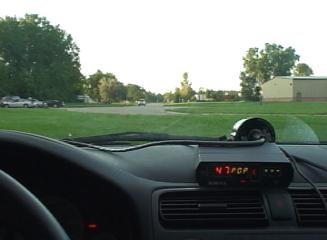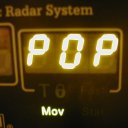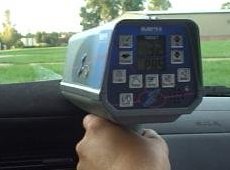


POP Mode is the latest attempt by a police radar manufacturer to defeat radar detectors. POP mode acquires a vehicle's speed by sending out a very quick burst of radar. This burst is so short that the latest detectors available at the time of POP's release didn't alert to it. Fortunately, some detector makers have since added POP detection capability to their detectors. It is important here to differentiate between the different kinds of POP mode. In the BEE and Enforcer Ka band units, the POP burst is about 67ms long (The BEE III and Enforcer also have K-Band units available). The Z-25 and Z-35 are only available in K-Band, and the POP burst in both of these units is much shorter, only about 16ms.  Even though POP is "non-evidential" (per the manual), it is still important to detect POP before it is "your turn". Once police identify a potentially speeding vehicle using POP mode, it is very easy to switch to conventional instant-on to obtain a court-recognized speed reading. In the case of the Z-25 and Z-35, this means simply holding in the trigger for an additional 1/2-second or so after reading the speed obtained from a POP burst. In the case of the BEE and Enforcer, when a POP speed is displayed a second press of the transmit button toggles the unit to instant-on.
Even though POP is "non-evidential" (per the manual), it is still important to detect POP before it is "your turn". Once police identify a potentially speeding vehicle using POP mode, it is very easy to switch to conventional instant-on to obtain a court-recognized speed reading. In the case of the Z-25 and Z-35, this means simply holding in the trigger for an additional 1/2-second or so after reading the speed obtained from a POP burst. In the case of the BEE and Enforcer, when a POP speed is displayed a second press of the transmit button toggles the unit to instant-on.Despite some websites that state that POP can only be used in stationary mode, the operator's manual for the MPH Enforcer that we used clearly states: "POP mode works in all radar modes: stationary, opposite direction moving mode, and same direction moving mode".  The radar units used for this test were the MPH Enforcer Ka band unit at (33.8 GHz) and the MPH Z-35. The MPH Enforcer is a "budget" version of the more widely known BEE III. The Enforcer and the BEE look exactly the same and are basically the same unit, except for a couple of differences: the Enforcer lacks a cordless remote (it has a corded one), and does not have the Automatic Same Direction (TM) feature like the BEE (manual same direction only). The MPH Z-35 is exactly the same unit as the MPH Z-25, except that it runs on a battery instead of a cord.
The radar units used for this test were the MPH Enforcer Ka band unit at (33.8 GHz) and the MPH Z-35. The MPH Enforcer is a "budget" version of the more widely known BEE III. The Enforcer and the BEE look exactly the same and are basically the same unit, except for a couple of differences: the Enforcer lacks a cordless remote (it has a corded one), and does not have the Automatic Same Direction (TM) feature like the BEE (manual same direction only). The MPH Z-35 is exactly the same unit as the MPH Z-25, except that it runs on a battery instead of a cord.The same test course that we used for our laser tests was used for POP testing. We measured out distances of 500 Feet, 1000 Feet, 1500 Feet, and 1786 feet and marked these with cones (The odd number of 1786 feet was used because that was a convenient spot on the course where the test vehicle would not block any driveways of businesses). All detectors had line of sight with the radar. We hit each detector with POP ten times with both the Enforcer and the Z-35. The test vehicle was started off at the 500-foot cone. For Ka Band 67ms POP, If the detector did not alert to POP mode at 500 feet, no further testing was done. But if the detector alerted to POP mode, then the vehicle was positioned at the next cone and the detector was re-tested. K Band 16ms POP was only tested at 500 feet. |
| BEL RX-65 v4.5 | 9/10 | 9/10 | 9/10 | 9/10 |
| Cobra XRS9700 | 0/10 | - | - | - |
| Escort Passport 8500 X50 Rev 5 | 8/10 | 10/10 | 6/10* | 9/10 |
| Valentine One v3.825 | 10/10 | 8/10 | 10/10 | 10/10 |
| Whistler Pro 58 ** | 5/10 | 3/10 | 6/10 | 4/10 |
|
* - At 1500 Feet, the Escort reported one POP hit as X-Band ** - After the GOL test results were published, we were informed by Whistler that because of the way the Pro 58 operates, after detecting POP the unit needs a few seconds after the alert ends to revert back to a "fast sweep" where it has the best chance of detecting POP. In our test, we only waited for the alert to end, and did not wait for a specific amount of time between POP hits. Thus, our test of the Whistler was not representative of it's true capabilities. Due to this fact, the same Pro 58 used in the GOL test was re-tested against the same Enforcer 67ms Ka unit, but this time with a five second pause between the time the POP alert ended and the next POP hit was transmitted. These are the results: @ ~528 Feet (1/10 Mile), it alerted 22/25 times @ ~1056 Feet (2/10 Mile) it alerted 22/25 times At both distances, the detector had line of sight with the targeting radar. |
| BEL RX-65 v4.5 | 0/10 |
| Cobra XRS9700 | 0/10 |
| Escort Passport 8500 X50 Rev 5 | 0/10 |
| Valentine One v3.825 | 1/10 |
| Whistler Pro 58 | 0/10 |

